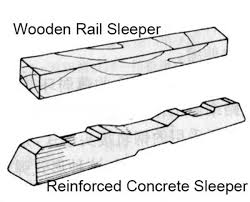Sleepers are the transverse ties that are laid to support the rails. They have an important role in the track as they transmit the wheel load from the rails to the ballast. Several types of sleepers are used on Indian Railways. The characteristics of these sleepers and their suitability with respect to load conditions are described in this section.
FUNCTIONS AND REQUIREMENTS OF SLEEPERS
The main functions of sleepers are as follows:
(a) Holding the rails in their correct gauge and alignment
(b) Giving a firm and even support to the rails
(c) Transferring the load evenly from the rails to a wider area of the ballast
(d) Acting as an elastic medium between the rails and the ballast to absorb the blows and vibrations caused by moving loads
e) Providing longitudinal and lateral stability to the permanent way
f) Providing the means to rectify the track geometry during their service life Apart from performing these functions the ideal sleeper should normally fulfil the following requirements.
g) The initial as well as maintenance cost should be minimum.
h) The weight of the sleeper should be moderate so that it is convenient to handle.
i) The designs of the sleeper and the fastenings should be such that it is possible to fix and remove the rails easily.
j) The sleeper should have sufficient bearing area so that the ballast under it is not crushed.
k) The sleeper should be such that it is possible to maintain and adjust the gauge properly.
l) The material of the sleeper and its design should be such that it does not break or get damaged during packing.
m) The design of the sleeper should be such that it is possible to have track circuiting.
n) The sleeper should be capable of resisting vibrations and shocks caused by the passage of fast-moving trains,
o) The sleeper should have anti-sabotage and anti-theft features.
SLEEPER DENSITY AND SPACING OF SLEEPERS
Sleeper density is the number of sleepers per rail length. It is specified as (M + x) or (N + x),where M or N is the length of the rail in metres and x is a number that varies according to factors such as
(a) axle load and speed,
(b) type and section of rails,
(c) type and strength of the sleepers,
(d) type of ballast and depth of ballast cushion, and
(e) nature of formation.
If the sleeper density is M+ 7 on a broad gauge route and the length of the rail is 13 m, it implies that 13 + 7 = 20 sleepers will be used per rail length of the track on that route. The number of sleepers in a track can also be specified by indicating the number of sleepers per kilometre of the track, for example, 1540 sleepers/km. This specification becomes more relevant particularly in cases where rails are welded and the length of the rail does not have much bearing on the number of sleepers required.
This system of specifying the number of sleepers per kilometre exists in many foreign countries and is now being adopted on Indian Railways as well. The spacing of sleepers is fixed depending upon the sleeper density. Spacing is not kept uniform throughout the rail length. It is closer near the joints because of the weakness of the joints and impact of moving loads on them. There is, however, a limitation to the close spacing of the sleepers, as enough space is required for working the beaters that are used to pack the joint sleepers. The standard spacing specifications adopted for a fish-plated-track on Indian Railways are given in Table below.

TYPES OF SLEEPERS
The sleepers mostly used on Indian Railways are
(i) wooden sleepers,
(ii) cast iron (CI) sleepers,
(iii) steel sleepers, and
(iv) Concrete sleepers
